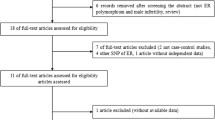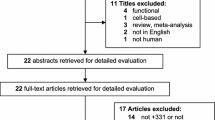Abstract
Excessive estrogenic influence is known to be associated with initiation/promotion of endometrial cancer (EC). Common variants among genes coding for enzymes in sex steroid biosynthetic pathways may influence the risk of EC. Cytochrome P450c17α (CYP17), a gene that codes for a key enzyme (cytochrome P450c17α) in a rate-limiting step of estrogen biosynthesis has attracted considerable attention as a candidate gene for EC. The relationship between CYP17 and EC has been reported in various ethnic groups; however, these studies have yielded contradictory results. To investigate this inconsistency, we performed a meta-analysis of 13 studies involving a total of 3,258 cases and 4,614 controls for −34T>C (rs743572) polymorphism of the CYP17 gene to evaluate the effect of CYP17 on genetic susceptibility for EC. An overall random effects odds ratio of 0.71 (95 % confidence interval 0.58–0.88, P = 0.001) was found under recessive genetic model. Stratified analysis based on ethnicity, sample size and Hardy–Weinberg equilibrium status was conducted to explore potential heterogeneity. This meta-analysis demonstrated that the C allele of −34T>C in CYP17 is a protective factor associated with decreased EC susceptibility, but these associations vary in different ethnic populations.



Similar content being viewed by others
References
Smith RA, Cokkinides V, Brawley OW (2009) Cancer screening in the United States, 2009: a review of current American Cancer Society guidelines and issues in cancer screening. CA Cancer J Clin 59:27–41
Deligdisch L, Holinka CF (1987) Endometrial carcinoma: two diseases? Cancer Detect Prev 10:237–246
Flototto T, Djahansouzi S, Glaser M et al (2001) Hormones and hormone antagonists: mechanism of action in carcinogenesis of endometrial and breast cancer. Horm Metab Res 33:451–457
Nebert DW, Dalton TP (2006) The role of cytochrome P450 enzymes in endogenous signaling pathways and environmental carcinogenesis. Nat Rev Cancer 6:947–960
Sharp L, Cardy AH, Cotton SC, Little J (2004) CYP17 gene polymorphisms: prevalence and associations with hormone levels and related factors. A HuGE review. Am J Epidemiol 160:729–740
Feigelson HS, Shames LS, Pike MC, Coetzee GA, Stanczyk FZ, Henderson BE (1998) Cytochrome P450c17alpha gene (CYP17) polymorphism is associated with serum estrogen and progesterone concentrations. Cancer Res 58:585–587
Feigelson HS, Coetzee GA, Kolonel LN, Ross RK, Henderson BE (1997) A polymorphism in the CYP17 gene increases the risk of breast cancer. Cancer Res 57:1063–1065
Holm K, Melum E, Franke A, Karlsen TH (2010) SNPexp—a web tool for calculating and visualizing correlation between HapMap genotypes and gene expression levels. BMC Bioinform 11:600
International HapMap Consortium (2003) The International HapMap Project. Nature 426:789–796
Stranger BE, Forrest MS, Dunning M et al (2007) Relative impact of nucleotide and copy number variation on gene expression phenotypes. Science 315:848–853
DerSimonian R, Laird N (1986) Meta-analysis in clinical trials. Control Clin Trials 7:177–188
Egger M, Davey Smith G, Schneider M, Minder C (1997) Bias in meta-analysis detected by a simple, graphical test. BMJ 315:629–634
Begg CB, Mazumdar M (1994) Operating characteristics of a rank correlation test for publication bias. Biometrics 50:1088–1101
Haiman CA, Hankinson SE, Colditz GA et al (2001) A polymorphism in CYP17 and endometrial cancer risk. Cancer Res 61:3955–3960
McKean-Cowdin R, Feigelson HS, Pike MC et al (2001) Risk of endometrial cancer and estrogen replacement therapy history by CYP17 genotype. Cancer Res 61:848–849
Berstein LM, Imyanitov EN, Kovalevskij AJ et al (2004) CYP17 and CYP19 genetic polymorphisms in endometrial cancer: association with intratumoral aromatase activity. Cancer Lett 207:191–196
Aban M, Arslan M, Tok E et al (2006) CYP17 genetic polymorphism in patients with endometrial hyperplasia and cancer. Int J Gynecol Cancer 16(suppl 1):448–451
Szyllo K, Smolarz B, Romanowicz-Makowska H, Lewy J, Kulig B (2006) The T/C polymorphism of the CYP17 gene and G/A polymorphism of the CYP19 gene in endometrial cancer. J Exp Clin Cancer Res 25:411–416
Chen C, Doherty JA, Weiss NS (2006) Polymorphisms in CYP17 and CYP19, unopposed estrogen use, body mass index, full-term pregnancy, and endometrial cancer risk. Proc Am Assoc Cancer Res 47:1269
Li R, Lu AN, Liao YM (2007) Correlation between gene polymorphism CYP17 and endometrial cancer. Zhongguo Ji Ceng Yi Yao 14:67–68 (in Chinese)
Gao J, Xiang YB, Xu WH, Cheng JR, Cai QY, Shu XO, Gao YT (2007) A case–control study on genetic polymorphism of CYP17 MspA(1)I and its association with endometrial cancer risk. Zhonghua Zhong Liu Za Zhi 29:266–269 (in Chinese)
Liu J, Yang YS, Qu X, Li H, Zhong YH (2007) Relation among single nucleotide polymorphism in estrogen metabolizing genes CYP17, COMT and endometrial adenocarcinoma risk. Shandong Daxue Xue Bao 45:18–21 (in Chinese)
Gaudet MM, Lacey JV Jr, Lissowska J, Peplonska B, Brinton LA, Chanock S, Garcia-Closas M (2008) Genetic variation in CYP17 and endometrial cancer risk. Hum Genet 123:155–162
Olson SH, Orlow I, Bayuga S et al (2008) Variants in hormone biosynthesis genes and risk of endometrial cancer. Cancer Causes Control 19:955–963
Hirata H, Hinoda Y, Okayama N et al (2008) CYP1A1, SULT1A1, and SULT1E1 polymorphisms are risk factors for endometrial cancer susceptibility. Cancer 112:1964–1973
Ashton KA, Proietto A, Otton G, Symonds I, McEvoy M, Attia J, Gilbert M, Hamann U, Scott RJ (2010) Polymorphisms in genes of the steroid hormone biosynthesis and metabolism pathways and endometrial cancer risk. Cancer Epidemiol 34:328–337
Spurdle AB, Thompson DJ, Ahmed S et al (2011) Genome-wide association study identifies a common variant associated with risk of endometrial cancer. Nat Genet 43:451–454
Chen Y, Saini S, Zaman MS, Hirata H, Shahryari V, Deng G, Dahiya R (2011) Cytochrome P450 17 (CYP17) is involved in endometrial cancinogenesis through apoptosis and invasion pathways. Mol Carcinog 50:16–23
Nedelcheva Kristensen V, Haraldsen EK, Anderson KB et al (1999) CYP17 and breast cancer risk: the polymorphism in the 5′ flanking area of the gene does not influence binding to Sp-1. Cancer Res 59:2825–2828
Jernström H, Vesprini D, Bradlow HL, Narod SA (2001) CYP17 promoter polymorphism and breast cancer in Australian women under age forty years. J Natl Cancer Inst 93:554–555
Dunning AM, Dowsett M, Healey CS, Tee L, Luben RN, Folkerd E, Novik KL, Kelemen L, Ogata S, Pharoah PD, Easton DF, Day NE, Ponder BA (2004) Polymorphisms associated with circulating sex hormone levels in postmenopausal women. J Natl Cancer Inst 96:936–945
Kaaks R, Lukanova A, Kurzer MS (2002) Obesity, endogenous hormones, and endometrial cancer risk: a synthetic review. Cancer Epidemiol Biomarkers Prev 11:1531–1543
Zeleniuch-Jacquotte A, Akhmedkhanov A, Kato I, Koenig KL, Shore RE, Kim MY, Levitz M, Mittal KR, Raju U, Banerjee S, Toniolo P (2001) Postmenopausal endogenous oestrogens and risk of endometrial cancer: results of a prospective study. Br J Cancer 84:975–981
Berstein LM, Imyanitov EN, Gamajunova VB, Kovalevskij AJ, Kuligina E, Belogubova EV, Buslov KG, Karpova MB, Togo AV, Volkov ON, Kovalenko IG (2002) CYP17 genetic polymorphism in endometrial cancer: Are only steroids involved? Cancer Lett 180:47–53
Author information
Authors and Affiliations
Corresponding author
Rights and permissions
About this article
Cite this article
Xu, J., Lin, X., Zhu, H. et al. Genetic variation of the CYP17 and susceptibility to endometrial cancer: a meta-analysis. Mol Biol Rep 40, 5085–5091 (2013). https://doi.org/10.1007/s11033-013-2609-0
Received:
Accepted:
Published:
Issue Date:
DOI: https://doi.org/10.1007/s11033-013-2609-0




